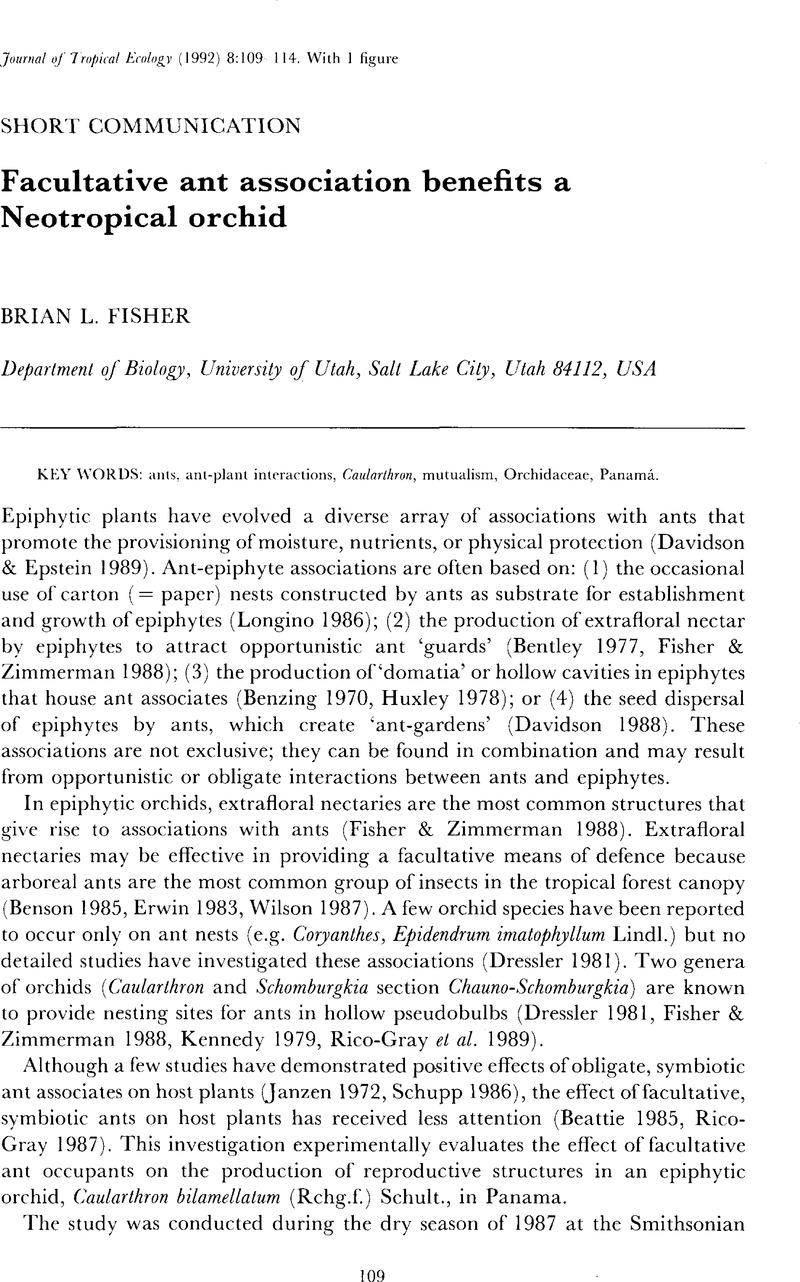Crossref Citations
This article has been cited by the following publications. This list is generated based on data provided by Crossref.
Alonso, Leeanne E.
1998.
Spatial and Temporal Variation in the Ant Occupants of a Facultative Ant‐Plant1.
Biotropica,
Vol. 30,
Issue. 2,
p.
201.
Agrawal, Anurag A.
1998.
LEAF DAMAGE AND ASSOCIATED CUES INDUCE AGGRESSIVE ANT RECRUITMENT IN A NEOTROPICAL ANT-PLANT.
Ecology,
Vol. 79,
Issue. 6,
p.
2100.
Meggers, B. J.
2003.
How Landscapes Change.
Vol. 162,
Issue. ,
p.
89.
TREMBLAY, RAYMOND L.
ACKERMAN, JAMES D.
ZIMMERMAN, JESS K.
and
CALVO, RICARDO N.
2004.
Variation in sexual reproduction in orchids and its evolutionary consequences: a spasmodic journey to diversification.
Biological Journal of the Linnean Society,
Vol. 84,
Issue. 1,
p.
1.
Wetterer, James K.
and
Keularts, Jozef L. W.
2008.
Population Explosion of the hairy crazy ant, Paratrechina Pubens (Hymenoptera: Formicidae), on St. Croix, US Virgin Islands.
Florida Entomologist,
Vol. 91,
Issue. 3,
p.
423.
Trager, Matthew D.
Bhotika, Smriti
Hostetler, Jeffrey A.
Andrade, Gilda V.
Rodriguez-Cabal, Mariano A.
McKeon, C. Seabird
Osenberg, Craig W.
Bolker, Benjamin M.
and
Raine, Nigel E.
2010.
Benefits for Plants in Ant-Plant Protective Mutualisms: A Meta-Analysis.
PLoS ONE,
Vol. 5,
Issue. 12,
p.
e14308.
Srimuang, Kanok-orn
Watthana, Santi
Pedersen, Henrik Æ.
Rangsayatorn, Niramol
and
Eungwanichayapant, Prapassorn D.
2010.
Flowering Phenology, Floral Display and Reproductive Success in the GenusSirindhornia(Orchidaceae): A Comparative Study of Three Pollinator-Rewarding Species.
Annales Botanici Fennici,
Vol. 47,
Issue. 6,
p.
439.
Yanoviak, Stephen P.
Berghoff, Stefanie M.
Linsenmair, K. Eduard
and
Zotz, Gerhard
2011.
Effects of an Epiphytic Orchid on Arboreal Ant Community Structure in Panama.
Biotropica,
Vol. 43,
Issue. 6,
p.
731.
Heil, Martin
2015.
Biological Nitrogen Fixation.
p.
1163.
Zotz, Gerhard
2016.
Plants on Plants – The Biology of Vascular Epiphytes.
p.
203.
Houlihan, Peter R.
Lucky, Andrea
Owen, Mike
and
Emmel, Thomas C.
2020.
Ants Tend Ghost Orchids: Patrolling of Dendrophylax lindenii (Orchidaceae) by Crematogaster ashmeadi in Florida.
Florida Entomologist,
Vol. 103,
Issue. 3,
Nußer, Ronja
Bianco, Giovanni
Kraus, Daniel
Larrieu, Laurent
Feldhaar, Heike
Schleuning, Matthias
and
Müller, Jörg
2024.
An adapted typology of tree-related microhabitats including tropical forests.
Ecological Indicators,
Vol. 167,
Issue. ,
p.
112690.



